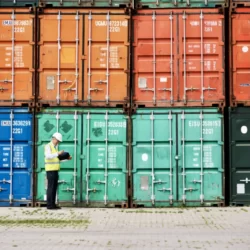Trade compliance: avoid unnecessary delays in the supply chain

Regulatory compliance is a tricky issue in international supply chains – especially in the current climate, when delivery problems are driving companies to look for alternative suppliers and transport routes. During Webinar Wednesday, Pincvision’s Dan Ipsen explained what the consequences can be: “If you’re not careful, you run the risk of suffering bigger delays than you already had.”
By Marcel te Lindert
Dan Ipsen talked about a real-life example: a shipment to Egypt that required much higher import duties to be paid than expected, and the entire shipment was actually held back at the border. As the customs specialist for the company involved, he was only called in when the damage had already been done. “The goods were correctly classified in our system, but the purchasing department had opted to have our supplier deliver directly to the end user in Egypt. Therefore, the Egyptian customs office used the product codes on the supplier’s invoice,” said Ipsen, who is now managing director of Pincvision UK, a service provider that helps companies worldwide to comply with international trade laws and regulations.
Based on the supplier’s product codes, part of the shipment was classified as ‘dual-use’ goods, meaning that they can also be used for military purposes. “As a result, we were not allowed to import them. We contacted Egyptian customs and managed to solve the problem eventually. We only succeeded because we had correctly classified the goods in our own system according to the correct procedures – and it took more than six months to convince customs of that fact.”
Import ban
Ipsen has unrivalled knowledge of the risks that companies with cross-border supply chains are exposed to, not least because so many internal and external links are involved. “Take the payment of import duties, which is usually the task of the finance department,” he said. “This requires data on the origin of the goods, which must be provided by purchasing or production. The same data is also needed for customs declarations and export documents.”
The risks can be considerable, according to Ipsen. For example, providing the wrong instructions to customs agents can lead to incorrect customs declarations and delays to shipments. “If that becomes a recurring problem, it can result in more intensive checks by customs – which could potentially lead to even more delays, heavy fines, dissatisfied customers and perhaps even a ban on importing goods into certain countries. If that means you can’t deliver to customers in those countries, your reputation will suffer.”
Personal liability
The biggest challenge right now lies in the growth in sustainability regulations. “These regulations are often strict and many businesses struggle to comply with them. It’s difficult for them to get a grip on the rules because they are new to many companies. And failure to do so can come at a high price, such as hefty fines, negative coverage in the press and on social media, and brand damage. There’s even a risk that senior executives can be held personally liable for misconduct.”
The current problems of components shortages and delays in container shipping are creating extra challenges. “Every time you make changes to your supply chain, such as by bringing containers from China by rail rather than by sea, you suddenly find yourself dealing with countries that you might not have dealt with before. And they might have different requirements which mean that you can’t fall back on free trade agreements. You need to check all that before making any changes to your goods flows. Otherwise, you run the risk of suffering bigger delays than you already had.”
Classification of goods
In particular, extra attention should be paid to the product codes. Customs offices worldwide work with the Harmonized System of codes, and Ipsen advised the webinar viewers to leave the classification of goods to the experts. “If you don’t have your own department for trade compliance, it’s important that the department that enters and records the information takes this issue seriously. That’s how you ensure that the information is always correct, and that everyone uses the same information. The key is to create a single version of the truth for everyone in the supply chain, both upstream and downstream. You shouldn’t leave that to procurement or sales, but take responsibility for it yourself as the supply chain department.”
The right product code can make a big difference, he explained. “Take mobility scooters. Importers prefer to give them the code for disabled vehicles, which qualifies them for a 0% import tariff, but customs offices use the code for golf carts which comes with an import tariff of 10%. You can challenge that decision in court, but there’s no guarantee of success.” He went on to give another example: gift boxes of goods such as perfume. “Importers regarded such gift boxes as qualifying for a 0% import tariff, but customs offices treated them the same as jewellery boxes, which have 3.7% import tariff. In this case, the court ruled in favour of the importers because the packaging is not designed to be reusable.”
Trade compliance checklist
Pincvision has worked together with Supply Chain Media to develop a checklist which enables companies to assess how well they are doing in the field of trade compliance by answering ten questions. The questions range from having reliable master data and a central storage system for data and documents, to processes for customs declarations and screening of trading partners. “If you answer a maximum of three questions with ‘no’, then you can conclude that your supply chain is compliant. But if you answer seven or more questions with ‘no’, then your supply chain is at serious risk. What’s more, you’re likely missing out on commercial opportunities,” he said.
Rounding off, Ipsen stated that trade compliance requires constant attention because international trade laws and regulations are constantly changing. He mentioned the transition of the Dutch customs office to a new declaration system (DMS), making the existing procedures for periodic declarations obsolete. Another example he gave was the new EU tax on single-use plastic packaging and the effect of Brexit. “The UK now has its own system of import tariffs, but companies that operate in the UK can receive a temporary discount or exemption. So if your company has offices in the UK, it’s important to keep an eye on whether you’re eligible for this.”










